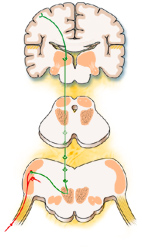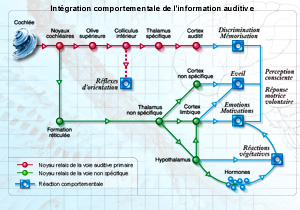| |
|
| Overview / Development and plasticity | |
| Drawings: S. Blatrix |
| |
|
| Overview / Development and plasticity | |
| Drawings: S. Blatrix |
| Auditory messages are conveyed to the brain via two types of pathway: the primary auditory pathway which exclusively carries messages from the cochlea, and the non-primary pathway (also called the reticular sensory pathway) which carries all types of sensory messages. |
| Primary auditory pathways | |
For details, see the zoom. |
|
| Non-primary pathways | |
 |
From the cochlear nuclei,
small fibers connect with the reticular formation where the auditory
message joins all other sensory messages. The next relay is in the
non-specific thalamus nuclei before the pathway ends in the polysensory
(associative) cortex. The main function of these pathways, also
connected to wake and motivation centers as well as to vegetative
and hormonal systems, is to select the type of sensory message to
be treated first. For instance, when reading a book while listening
to a record, this system allows the person to pay attention alternately
to the most important task. For details, see the zoom. |
| Sensation and conscious perception | |

|
Conscious perception
requires the integrity of both types of pathways. For instance,
during sleep the primary auditory pathway functions normally, but
no conscious perception is possible because the link between reticular
pathways and the wake and motivation centers is inactive. Conversely,
trauma affecting the cortex may suppress the conscious perception,
while the continuing integrity of the non-primary pathways may result
in vegetative reflex reactions to a sound. Also, because the brain
stem and midbrain are intact, Preyer reflexes are still present. For details, see the zoom. |
 |
For
permission to non-commercial use of any element of this site, please contact us All rights reserved © 1999 - 2007 The authors Intellectual property law 85-660 (07/03/1985) |
|